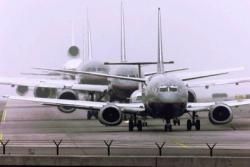Controllers Say There Have Been Many Close Calls
With additional focus on airport congestion and the potential
for runway incursions, one of the first maneuvers any student pilot
learns is facing additional scrutiny by federal authorities: the
go-around.

The Associated Press reports the FAA recently reviewed go-around
procedures at three of the nation's airports, including Newark
Liberty -- where the arrival ends for runways 22L, 22R and 29
intersect at the northeast corner of the field. Simultaneous
approaches to those runways can result in one or more go-arounds,
if the spacing isn't adequate.
Last year, authorities discontinued a go-around procedure used
at Detroit Metro, which sent planes landing on 27R directly into
the takeoff paths of aircraft on parallel runways 21R and 22L.
Similar changes were made in Memphis, after a Northwest DC-9
landing on runway 18R flew over a commuter plane going around on
intersecting runway 27 due to a mechanical issue. In that case,
controllers told the RJ to stay low over the runway, to avoid the
Northwest plane.
Go-arounds haven't been cited as the cause for any accidents or
midair collisions involving commercial airliners for over 30
years... but controllers are concerned about the close calls that
could have gone the other way. A review of tower logs at eight
airports conducted by the AP found over 1,500 go-arounds in the
last six months of last year.
"We can go 99 percent of the time and not have a problem. But it
only takes one," said John Wallin, president of the Memphis branch
of the National Air Traffic Controllers Association.
The overwhelming cause of go-arounds has to do with improper
spacing -- an aircraft on final approach is too close to landing
traffic ahead, or a plane that hasn't yet cleared the active.
That's a particular problem at the nation's busiest airports, where
planes land and depart as often as every two minutes.
Shifting winds can also lead to go-arounds, as can runway
incursions by taxiing aircraft or ground vehicles. And, usually,
they're a non-event, stressed 20-year airline pilot Ralph
Paduano.
"We're trained in that maneuver, so it's not a tense situation,"
said Paduano, who now flies for Continental. "But you have to
really be on the ball; you can't be complacent about it."
Pilots are familiar with the mechanics of a go-around; whether
in a single-engine Cessna or a Boeing 747, the forces at work are
the same. Pilots must quickly reconfigure a "dirty" plane -- flaps
and slats out, traveling low and slow on approach to the runway --
to fly again. In a commercial airliner, flight crews must also
factor in the lag time for turbofan powerplants to spool up to
full-power.
 At Newark, nearly half of the close
to 300 go-around recorded between August 2007 and January 2008 were
caused by runway "ties," with planes approaching intersecting
runways at the same time and at roughly the same spacing. To avoid
potential conflicts, controllers at Newark have taken to
"staggering" arrivals on intersecting runways.
At Newark, nearly half of the close
to 300 go-around recorded between August 2007 and January 2008 were
caused by runway "ties," with planes approaching intersecting
runways at the same time and at roughly the same spacing. To avoid
potential conflicts, controllers at Newark have taken to
"staggering" arrivals on intersecting runways.
"You have about eight miles, or about two minutes, to figure it
out and make it work" after approach control hands off a landing
aircraft to the tower, said Ray Adams, vice president of the
controllers union at the airport. "It comes down to how busy you
are and what your skill level is. You have to make some serious
moves pretty early to get the sequence to work out."
At the behest of the Department of Transportation's Inspector
General, the FAA is now reviewing landing procedures at Newark. So
far, the FAA told the AP, it's "found no safety issues" since the
staggering procedure was implemented last year.
 ANN's Daily Aero-Linx (04.16.24)
ANN's Daily Aero-Linx (04.16.24) Aero-News: Quote of the Day (04.16.24)
Aero-News: Quote of the Day (04.16.24) Airborne 04.10.24: SnF24!, A50 Heritage Reveal, HeliCycle!, Montaer MC-01
Airborne 04.10.24: SnF24!, A50 Heritage Reveal, HeliCycle!, Montaer MC-01 Airborne 04.12.24: SnF24!, G100UL Is Here, Holy Micro, Plane Tags
Airborne 04.12.24: SnF24!, G100UL Is Here, Holy Micro, Plane Tags Airborne-Flight Training 04.17.24: Feds Need Controllers, Spirit Delay, Redbird
Airborne-Flight Training 04.17.24: Feds Need Controllers, Spirit Delay, Redbird




